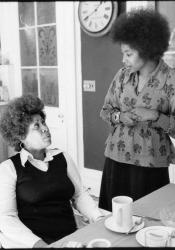Alice Walker's, In Search of Our Mothers' Gardens
“We are a people. A people do not throw their geniuses away. And if they are thrown away, it is our duty as artists and as witnesses for the future to collect them again for the sake of our children, and, if necessary, bone by bone” (Walker 92).
Alice Walker begins the first chapter of her book, In Search of Our Mothers’ Gardens by mentioning her encounter with racist anthropologists in the late 1970s while researching material on voodoo practices for her book. She claims that her disappointment with the material she found from these anthropologists and folklorists stemmed from their idea that black people were “inferior, peculiar, and comic”. This account at the beginning of the chapter can be seen as a rhetorical move from Walker because it sets up a lens for the reader to view the rest of her chapter/book with.
The first chapter that we read from Walker touches on the fight against censorship and silencing of black people, particularly black women artists, along with the importance of legacy, survival, and generational storytelling. Through Walker’s praise of Zora Neale Hurston, she touches on the importance of authentic portrayals of the lives and cultures of black Americans giving an example of how her relatives, who grew up in the South but moved to New York, reacted when they read Hurston’s Mules and Men. Walker states that this book worked in bringing back “all the stories they had forgotten or of which they had grown ashamed of” and in turn showing them how valuable and priceless those stories really were (85). This example is important for the understanding of this chapter because it touches on Walker’s idea of racial health where we would see and have “a sense of black people as complete, complex, undiminished human beings” within the way they are portrayed by society, something that she feels is lacking in black writing and literature.
Walker also makes a point to mention that most contemporary black Americans believed at some point that their “blackness was something wrong with them” (86). Walker connects this to her point about a lack of racial health because as she says with the white racist anthropologists, perceptions of black culture and people, in general, were that they were inferior, peculiar, and comic in relation to white people. This effect of this perception being the only narrative readily available and persistent in society led to many black Americans eventually believing it to be true, losing part of their agency, self-respect, and forgetting the beauty and value of their own culture.
Walker states that “America does not support or honor black people as human beings let alone black, women, and artists so they have to take the assistance they can in order to secure that their cultural heritage would survive and their writing would be preserved“ (91). This was said in response to her mention that even Zora, the self-respecting author, became timid in her writing and her words became false due to her financial reliance on “white folks” but as the quote says Zora sacrificed part of her own integrity so that she would be able to preserve her writing and secure her cultural heritage (91).
-----------------
“Guided by my heritage of a love of beauty and respect for strength- in search of my mother’s garden, I found my own” (Walker 243).
Walker begins this chapter by talking about how poet, Jean Toomer saw black women in the Post Reconstruction South as women who had been so consistently abused, sexualized, and dimmed. Walker states that all of that abuse is believed to have made them so confused they began to believe that they were unworthy of hoping for anything more/better and in turn pushed down all of the things that made them unique, beautiful, and genius (233).
This chapter really takes a close look at the history and lineage of how black woman artists got to be artists despite the extreme abuse and hardship that their mothers and grandmothers endured. Walker asks “What did it mean for a black woman to be an artist in our grandmother's time?” a question that she swiftly follows up with accounts of abuse and hardship of being kept as a slave, working for ignorant people who weren’t able to see how valuable and beautiful these black lives were. This account of the abuse then leads her to ask about how, even through all of that, the creativity of black women could stay alive?
Walker states that she turned to her own mother to try and answer this question and she found that even though her mother was working all of the time and rarely had a moment to be alone with her thoughts, she expressed her creativity through the materials and mediums that society presented to her, whether that was through the oral stories that Walker’s mother told her at bedtime or the garden that she tended to. Walker says that these mothers and grandmothers, despite the hardship and abuse they endured, found ways to pass on the creative spark that they couldn’t quite see actualized themselves but that they knew had value to be passed down.

